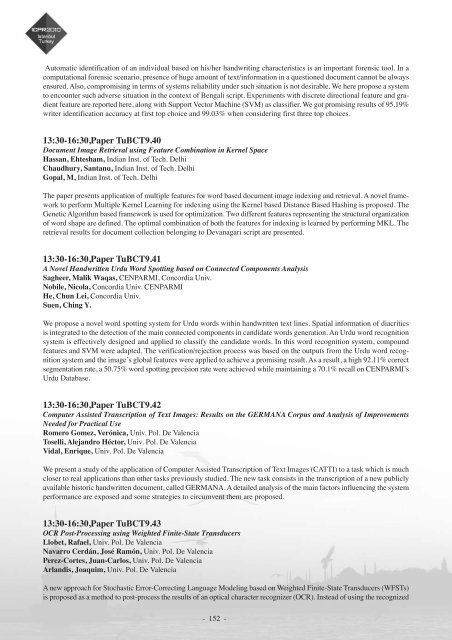Abstract book (pdf) - ICPR 2010
Abstract book (pdf) - ICPR 2010
Abstract book (pdf) - ICPR 2010
- TAGS
- abstract
- icpr
- icpr2010.org
Create successful ePaper yourself
Turn your PDF publications into a flip-book with our unique Google optimized e-Paper software.
Automatic identification of an individual based on his/her handwriting characteristics is an important forensic tool. In a<br />
computational forensic scenario, presence of huge amount of text/information in a questioned document cannot be always<br />
ensured. Also, compromising in terms of systems reliability under such situation is not desirable. We here propose a system<br />
to encounter such adverse situation in the context of Bengali script. Experiments with discrete directional feature and gradient<br />
feature are reported here, along with Support Vector Machine (SVM) as classifier. We got promising results of 95.19%<br />
writer identification accuracy at first top choice and 99.03% when considering first three top choices.<br />
13:30-16:30,Paper TuBCT9.40<br />
Document Image Retrieval using Feature Combination in Kernel Space<br />
Hassan, Ehtesham, Indian Inst. of Tech. Delhi<br />
Chaudhury, Santanu, Indian Inst. of Tech. Delhi<br />
Gopal, M, Indian Inst. of Tech. Delhi<br />
The paper presents application of multiple features for word based document image indexing and retrieval. A novel framework<br />
to perform Multiple Kernel Learning for indexing using the Kernel based Distance Based Hashing is proposed. The<br />
Genetic Algorithm based framework is used for optimization. Two different features representing the structural organization<br />
of word shape are defined. The optimal combination of both the features for indexing is learned by performing MKL. The<br />
retrieval results for document collection belonging to Devanagari script are presented.<br />
13:30-16:30,Paper TuBCT9.41<br />
A Novel Handwritten Urdu Word Spotting based on Connected Components Analysis<br />
Sagheer, Malik Waqas, CENPARMI, Concordia Univ.<br />
Nobile, Nicola, Concordia Univ. CENPARMI<br />
He, Chun Lei, Concordia Univ.<br />
Suen, Ching Y.<br />
We propose a novel word spotting system for Urdu words within handwritten text lines. Spatial information of diacritics<br />
is integrated to the detection of the main connected components in candidate words generation. An Urdu word recognition<br />
system is effectively designed and applied to classify the candidate words. In this word recognition system, compound<br />
features and SVM were adapted. The verification/rejection process was based on the outputs from the Urdu word recognition<br />
system and the image’s global features were applied to achieve a promising result. As a result, a high 92.11% correct<br />
segmentation rate, a 50.75% word spotting precision rate were achieved while maintaining a 70.1% recall on CENPARMI’s<br />
Urdu Database.<br />
13:30-16:30,Paper TuBCT9.42<br />
Computer Assisted Transcription of Text Images: Results on the GERMANA Corpus and Analysis of Improvements<br />
Needed for Practical Use<br />
Romero Gomez, Verónica, Univ. Pol. De Valencia<br />
Toselli, Alejandro Héctor, Univ. Pol. De Valencia<br />
Vidal, Enrique, Univ. Pol. De Valencia<br />
We present a study of the application of Computer Assisted Transcription of Text Images (CATTI) to a task which is much<br />
closer to real applications than other tasks previously studied. The new task consists in the transcription of a new publicly<br />
available historic handwritten document, called GERMANA. A detailed analysis of the main factors influencing the system<br />
performance are exposed and some strategies to circumvent them are proposed.<br />
13:30-16:30,Paper TuBCT9.43<br />
OCR Post-Processing using Weighted Finite-State Transducers<br />
Llobet, Rafael, Univ. Pol. De Valencia<br />
Navarro Cerdán, José Ramón, Univ. Pol. De Valencia<br />
Perez-Cortes, Juan-Carlos, Univ. Pol. De Valencia<br />
Arlandis, Joaquim, Univ. Pol. De Valencia<br />
A new approach for Stochastic Error-Correcting Language Modeling based on Weighted Finite-State Transducers (WFSTs)<br />
is proposed as a method to post-process the results of an optical character recognizer (OCR). Instead of using the recognized<br />
- 152 -



